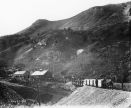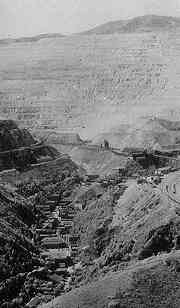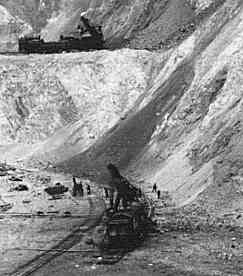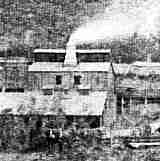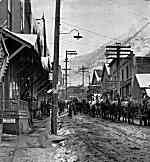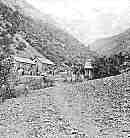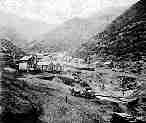Bingham Canyon, Utah
Even in the most conservative of estimates, the Hickmans lost billions of dollars at Bingham Canyon. They also lost hundreds of millions at Alta and Mercur. We don't know the whole story, so they probably lost a lot of money at other locations as well, maybe even Wendover. Don't feel too bad about this. It's an inherited family trait. Where were you when they were selling stock in Microsoft at 50 cents a share? Of course, this isn't a good analogy. It's more like the Hickmans bought at 50 cents, then sold when the stock dropped briefly to 49 before beginning its parabolic increase. If this sounds like you, then you must be a Hickman.
These are some pictures of the place where the Hickman family began going broke. In fairness to others of Bingham's first families, the Hickmans weren't the only ones.
(Click on the image you wish to see enlarged)
This is what Bingham Canyon looked like before there was open pit mining. Virtually everything you see here has been removed.
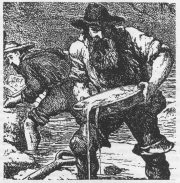
Also known as the Jordan or Old Jordan, by 1896 this underground mine in Upper Bingham had produced over $18,000,000 in lead, silver, and gold. Bill Hickman sold out his interest in the mine in 1871 for $150. The mine became the nucleus of a major Utah mining company, the United States Smelting, Refining and Mining Company, which operated at Bingham until 1972.
Galena Gulch, or Upper Bingham. This view shows the surface facilities of the U.S. Mine near the discovery site of Utah's first mining claim, the Jordan.
The Highland Boy in Carr Fork began as a gold mine, but in 1896 as the operation moved from oxide ores into sulfides, it ran out of gold and into copper--an unexpected success story.
This is a view inside the Utah Apex mine, adjacent to the Highland Boy who defeated its neighbor in a long and expensive lawsuit. In the late 1920s despite being an underground mine, the Utah Apex was the biggest copper producer in Utah.
The Utah Copper property in 1904, two years before open pit mining began. Until the oxidized capping was removed, about 1909, nearly all of the ore was mined from a network of tunnels.
This is an aerial view of the present-day Kennecott Utah Copper Bingham Canyon Mine. In the year 2006 it will have been in nearly continuous operation for a hundred years. Click here and you can also see a computer-generated view of the canyon before there was an open pit mine, also an anaglyph of the Oquirrh Mountains.
This is one of a series of four pictures of Bingham Canyon in 1909. Click here to see them.
Here are two rare views of Bingham Canyon's first smelter, which operated from 1871 to 1873. You can also see its second smelter, 1871 to 1875. Click here.
To tour downtown Bingham City in the early 1950s, click here.
To visit the Hickman Map Room, click here.
To see additional pictures of Bingham in Mark Evans' collection, click here.
TV station KUED recently did a show featuring Bingham pictures; click here.
To read Don Strack's history of Bingham Canyon railroads, click here.
To view Don's Bingham railroad pictures and documents, click here.
The Shipler photograph collection includes many pictures of Bingham: click here.
To read the Salt Lake Mining Review (1899-1929), click here.
To return to the Hickman Museum Index page, click here.
.
Ore wagons drawn by teams of horses once were so common a sight at Bingham that apparently no one bothered to take a photograph of them. We can get some idea of what it looked like in this view, as a team of horses hauls out the wreckage of a locomotive down Bingham's narrow street about 1912. Click here for a closer look.
Bingham was a city with over 30 different nationalities. One of its most popular citizens was Billy Cloud, Bingham's only Negro. Click here.
To see an early stereo view of one of Bingham Canyon's numerous gold mines, click here.
To visit a mining property in Carr Fork Canyon, click here.





